
|

|
|
Home Site Search Contact Us Subscribe
|
|
|
Veni, Vidi, Vici: Museo MAXXI by Zaha Hadid Architects Rome, Italy: The ancient city's newest museum is a reminder that here is a woman at the top of the field - and a testament to the fact that women build, and build well. By Ann Lui July 20, 2010 At the architectural opening of the MAXXI Museo nazionale delle arti del XXI secolo (National Museum for XXI Century Arts), Zaha Hadid was asked how it felt to be “the first woman to design a public building in the city of emperors.” She responded, “I don’t know. I’ve always been a woman. I don’t go around thinking of myself as a woman on a daily basis.”
Lucky for you, Zaha – the architecture field, however, cannot and should not forget the fact of your sex. The MAXXI stands as a testament to the struggle of female architects all over the world. (The word “struggle” here is especially apt considering the staggering construction costs of €150 million for a museum 10 years in the making.) The MAXXI is notably the first public building by a woman in Rome – and the largest completed project, to date – by the world’s most famous female architect.
Two months before the official opening, I had the opportunity to visit the MAXXI, located in a residential neighborhood away from the historic center. Getting to the museum from where I live was like experiencing the greatest hits of Rome: past the Pantheon to Piazza del Popolo, along the Tiber and Richard Meier’s Ara Pacis, then on the tram by Nervi’s Palazzo dello Sport.
What became apparent to me, as a female designer, is that architecturally Rome is a man’s city through and through.
Unlike in the United States, where the majority of buildings were constructed in the stylistically nebulous era of the 19th and 20th centuries by faceless developers, unique buildings are the heart of Rome – strung like pearls across the city center. From the ancient ruins, commissioned by and named after powerful males, to the modern architectural landscape teeming with male starchitects, Rome remains a “city of emperors.” From Hadrian to Renzo Piano, Maecenas to Rem Koolhaas – it’s an architectural bro-fest.
But then, just when you might start to lose heart, there’s Zaha. I realized that I had arrived when, walking along Via Masaccio, I saw Hadid’s signature train-track forms cantilevering up into the sky.
What is important about the formalism of MAXXI, in a feminist reading, is that it is incredibly distinctive. Hadid’s indentity, which is inextricable from her architectural style, is a constant reminder that here is a woman at the top of the field.
Hadid has cultivated a unique formalism since she was at the Architectural Association. Striving in an attic for nights on end, she painted the works that would go on to inform her later built projects. Those weaving linear forms in black steel and concrete start first on canvas in the 1970s, then wind their way to the Hong Kong Peak master plan, wander through the Vitra Firehouse at Weil-am-Rhein, drawn by a master hand again and again – they bend through the packed streets of Cincinnati in 2003, then one year later up and off a ski jump, white like the snow, twisting and turning and finally coming to crescendo in the MAXXI museum.
The museum itself is all about speed and movement. Long lines bend around the L-shaped site, becoming anything from drains to staircases to exhibition galleries. Made of concrete, glass, steel, and furniture coated in fiberglass, the building is the seamless inter-weaving of different threads. One enters through a wide exterior space (where the planters are Z-shaped, too), as concrete forms fly overhead like urban overpasses. Inside, the visitor inhabits those highways – staircases are made from the same shapes, allowing those below to see the passeggiata of those above. At MAXXI, it seems that nobody walks. Instead, everyone glides, as if Hadid’s forms were moving walkways. It is, of course, a well-engineered trick for visitors to see the museum without any art: it shows off the building’s geometries and forms.
It would be stereotyping to say that the MAXXI is a feminine building because it is curvy. Of course, architects love telling the story about how Le Corbusier only built buildings with straight, orthogonal lines until he went to Algiers, where he spent a year ostensibly enjoying full-figured women, and came back to build the most beautiful doubly-curved surfaces architecture had ever seen. However, these are gender-normative ideas, and do not do justice to Hadid’s latest work.
The MAXXI is relevant because it is a unique work by a female architect, unmistakable for the work of anyone else. One sees it and realizes at once – Ah, Zaha – her capes, her paintings, her reputation, her wild hair, and unavoidably, her gender. Through the sheer force of her personality – architectural and otherwise – she’s a testament to the fact that women build, and build well.
The group of students I visited the MAXXI with was split evenly in terms of gender. However, the statistics are scary: the National Architectural Accrediting Board reports that women make up 41% of architecture students, yet the AIA Firm Survey, in turn, reports that only 27% of firms’ members are women, and ultimately, only 17% are principals.
Why are women dropping out of architecture? Is it the usual feminist culprit of the biological clock? It’s true that other than Hadid, famous female designers are usually in married pairs: Reiser + Umemoto, SHoP architects, Weiss/Manfredi, Foreign Office Architects (who are now divorcing, but it’s the same story), Ray & Charles Eames. Even the Pritzker Prize venerated Robert Venturi in 1991, while his wife and long-time design partner Denise Scott Brown was ignored.
Or perhaps the nurturing of architects is to be blamed: sexism is especially stinging in a field that, beginning in academia, correlates self-worth with the approval and acceptance of older architects (critics and professors on juries) most of whom are male. A female colleague of mine was recently targeted at a review by critics who claimed, “It’s obvious that a girl like you has never gone camping in her life,” when presenting a sustainable plan for alternative housing in national parks. When success in school depends on public recognition at studio reviews, a handful of slights from a predominantly older, male generation can become a professional concern.
Here’s the thing about MAXXI: it’s a Rorschach test. People see in it what they want to see in architecture, because it is new and good and full of potential. New York Times architecture critic Nicolai Ouroussoff, always looking to the past, called it a modern-day Bernini – proof that modern architects can be as good as the Baroque. Pierre Alexandre de Looz, in The Times magazine compared it to the works of Fellini – a side-door for modern architecture to be accepted by the ancient city. I see the MAXXI as a symbol of the sole-standing female starchitect because that is what I am looking for. I’m young, female, about to graduate, and I want to know that I can be a top-tier designer without having to marry one. The MAXXI is veritable proof that I can.
Ann Lui is a fifth-year student of architecture at Cornell University, and is currently studying in Rome. She is a former Arts & Entertainment Editor of the Cornell Daily Sun, where she continues to write the column “Paper Architect” about issues related to the design field, academia, and general pop culture. Thoroughly afflicted with wander lust, Ann has lived in San Francisco and Buenos Aires, and will be taking a year off from school to move to Basel, Switzerland, where she plans to continue writing and designing. She can be reached at all48@cornell.edu. |
(click on pictures to enlarge) 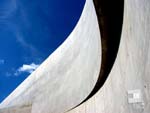 R. Galass, courtesy Fondazione MAXXI MAXXI by Zaha Hadid Architects  R. Galass, courtesy Fondazione MAXXI MAXXI at night 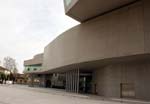 Ann Lui Unlike typical Roman buildings, Hadid's MAXXI has no front façade; instead, the building forms an L-shape around an entrance piazza.  R. Galass, courtesy Fondazione MAXXI Exterior detail 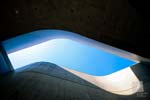 Simone Cecchetti, courtesy Fondazione MAXXI Exterior detail 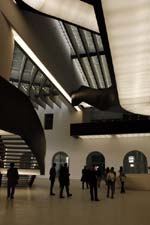 Ann Lui Form work: The entrance hall to the museum feels like standing beneath a series of overpasses: stairways and walkways overhead connect to more exhibition halls upstairs. Structural beams in the ceiling reflect the curvature of the floor plan. 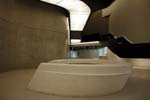 Ann Lui It's in the details: The reception desk in the entrance hall is an example of Hadid's ability to design at small and large scales. The furniture, all designed by Hadid, is concrete coated in painted fiberglass. 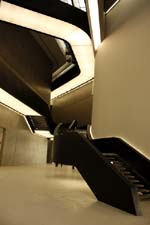 Ann Lui Upward movement at light speed: The staircase in the entrance lobby connects the first-floor reception area to exhibition spaces above. Lighting details change throughout the building, from the wide bands of light beneath overhead walkways to individual fixtures above the entrance hall flecked like splashes from a paintbrush. 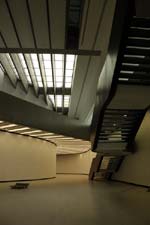 Ann Lui Color and shape: In this first floor exhibition suite just inside the entrance, the material palette picks up different colors of natural light, from the deep black of the stairs to hints of green in the concrete floor. |
© 2010 ArchNewsNow.com